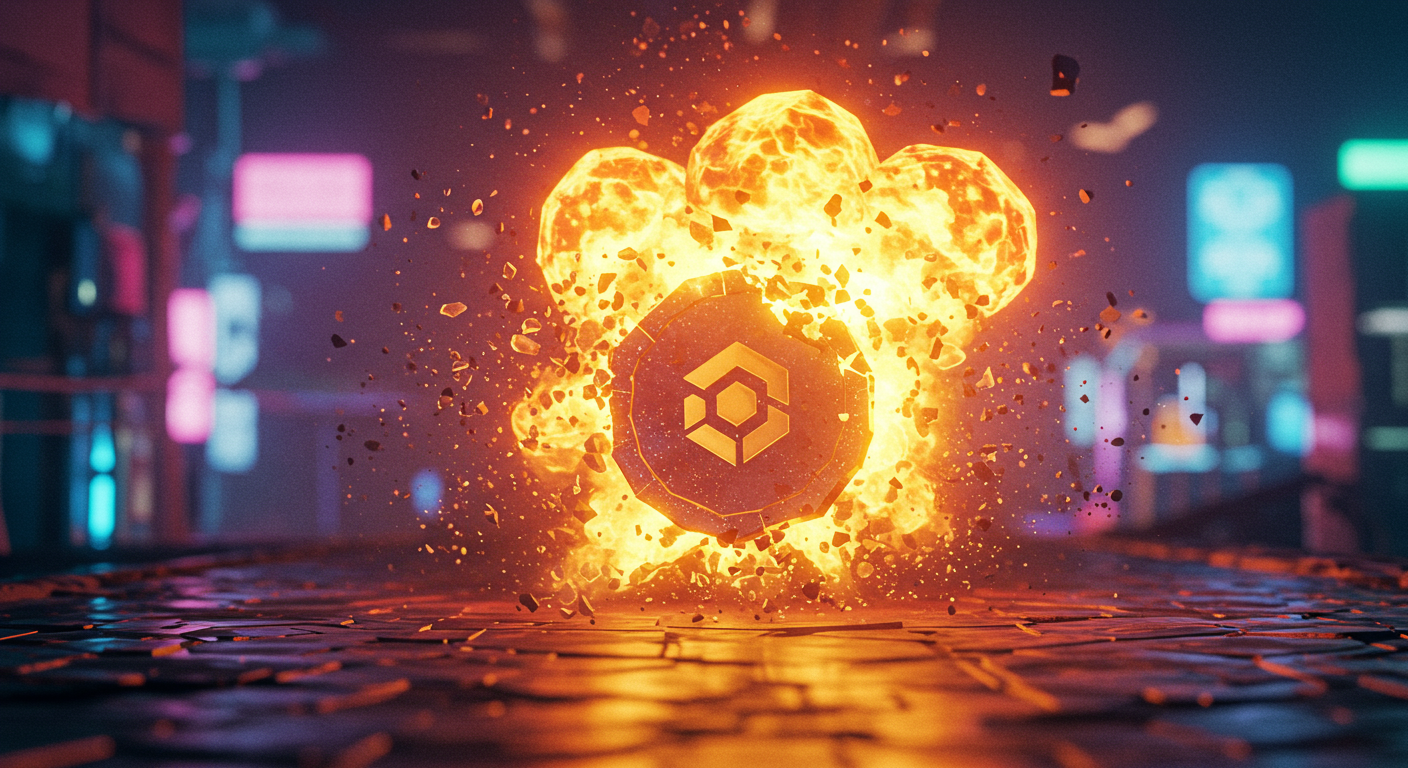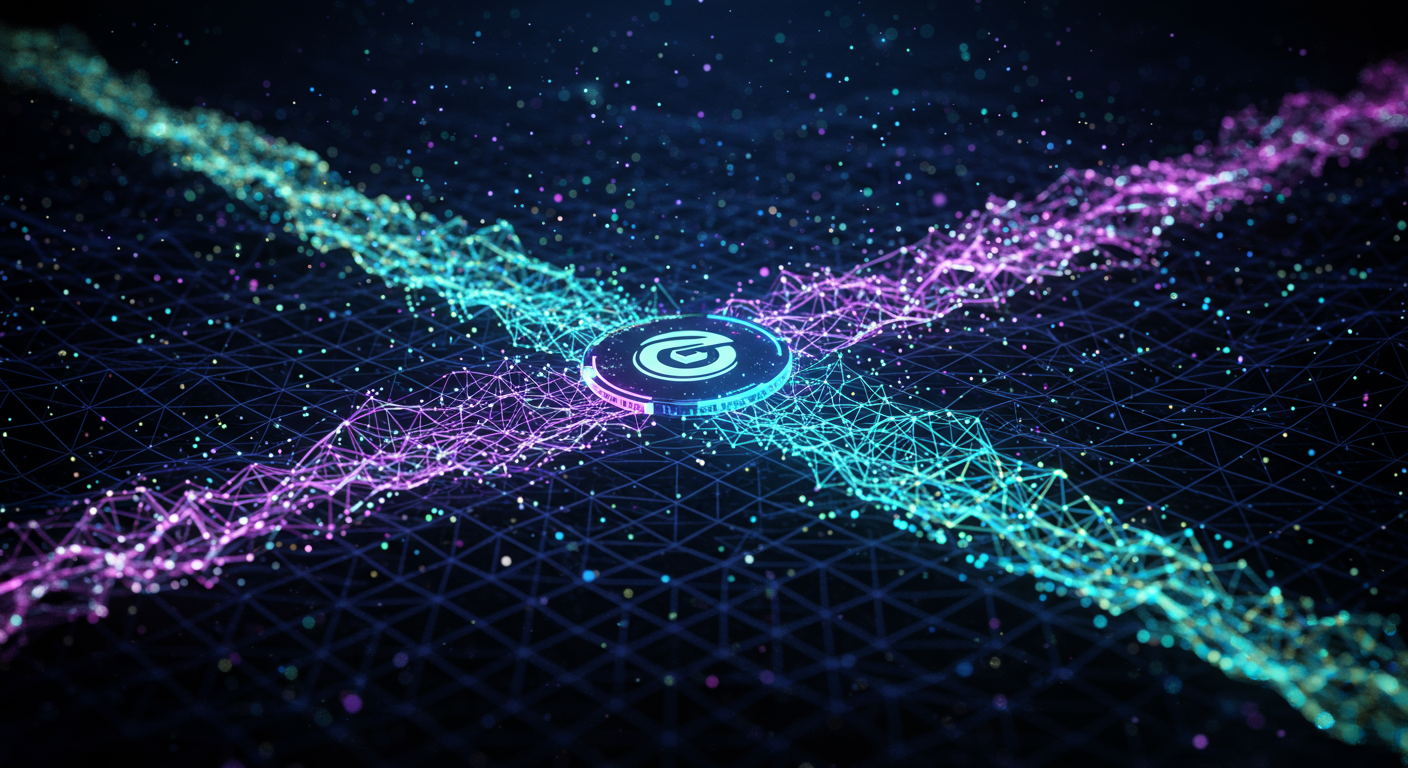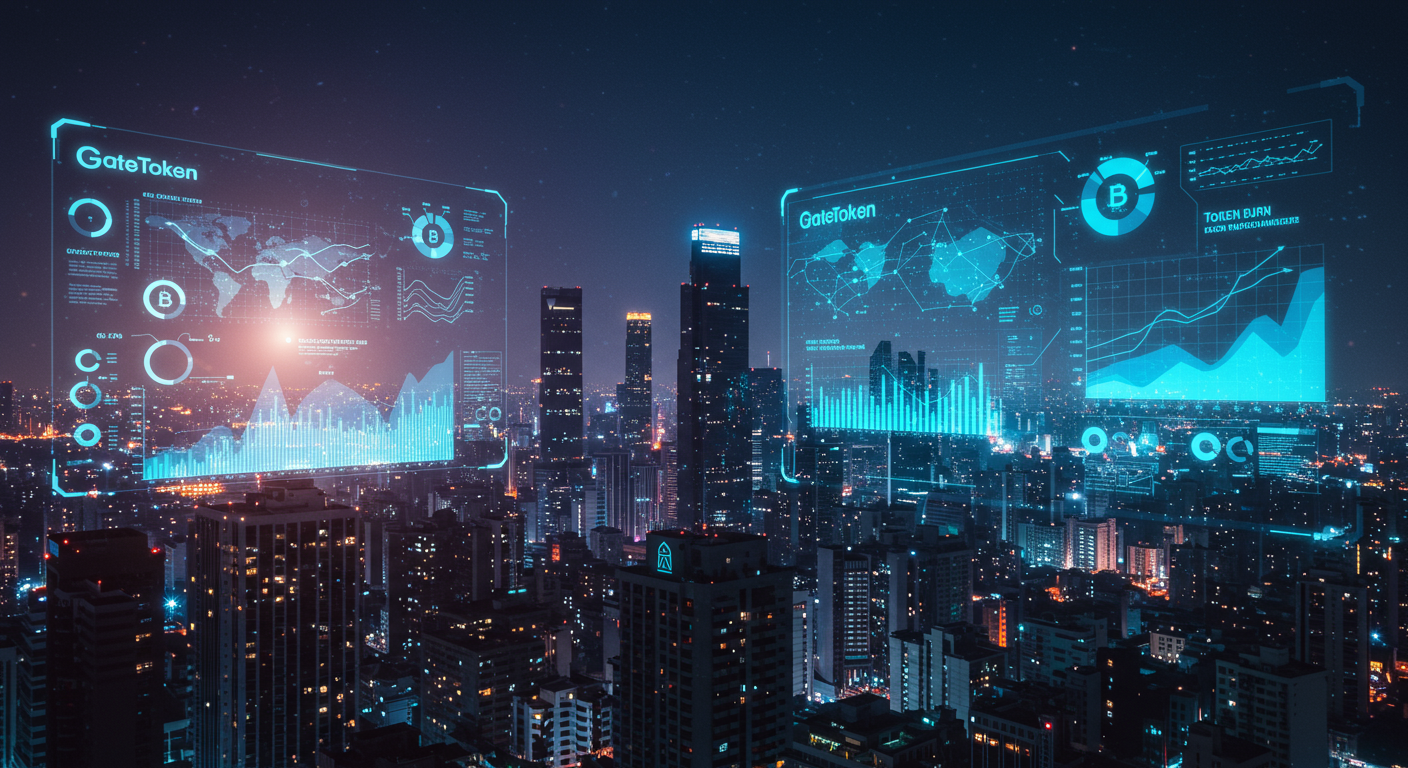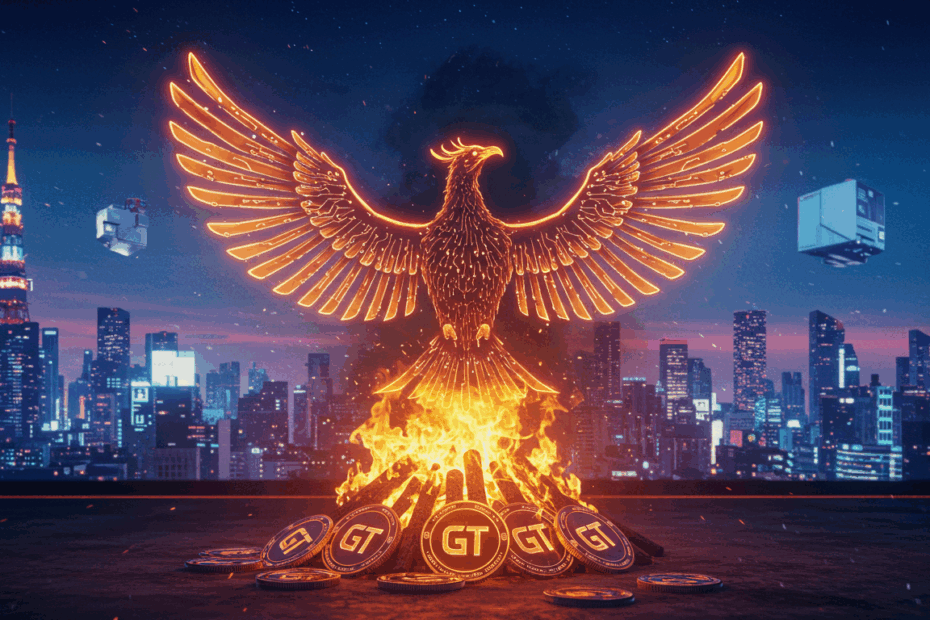Unpacking the Engine: A Beginner’s Guide to GateToken, Token Burns, and the Blockchain Behind It All
John: Welcome, everyone. In the ever-shifting landscape of digital assets, certain mechanisms consistently capture the market’s attention. One of the most fascinating is the concept of a ‘token burn.’ We’ve seen a lot of chatter recently, especially with the latest news that Gate has completed its Q2 2025 burn of its native GateToken (GT), taking a significant number of tokens permanently out of circulation. Today, Lila and I are going to pull back the curtain on this. We’ll explore what GateToken is, why anyone would deliberately destroy valuable assets, and how the underlying blockchain technology makes it all possible.
Lila: That’s a great place to start, John. Because for a newcomer, the phrase “token burn” sounds pretty dramatic, maybe even destructive! Before we get into the ‘burning’ part, can you give us the foundational knowledge? What exactly is GateToken, or GT, for someone who’s maybe only heard of Bitcoin or Ethereum?
John: An excellent starting point. Think of it like this: if the Gate.io cryptocurrency exchange were a country, GateToken (GT) would be its native currency. It’s the utility token that powers the entire Gate ecosystem. It was launched by Gate.io, a global cryptocurrency exchange platform that has been around since 2013, making it one of the more established players in the space. GT isn’t just a speculative asset; it’s deeply integrated into the platform’s operations and is also the fuel for its own public blockchain, GateChain. It’s designed to have real, tangible use-cases within that ecosystem.
Lila: So it’s not just for trading, it has a job to do. I think that’s a key distinction many beginners miss. They see tokens as digital stocks, but the utility aspect is crucial. You mentioned it powers the ecosystem, which I find really interesting. It gives the token an intrinsic purpose.

The Core Concepts: What is GateToken (GT)?
John: Precisely. Utility is the name of the game for a token’s long-term relevance. GateToken serves multiple functions. For users of the Gate.io exchange, holding GT can provide trading fee discounts, which is a powerful incentive for active traders. It also grants access to special events, like their ‘Startup’ platform, where users can get early access to new and promising crypto projects. Beyond the exchange itself, GT is the native gas token (a token used to pay for transaction fees) for the GateChain blockchain. If a developer wants to build a decentralized application (dApp) on GateChain, they and their users will need GT to process transactions and execute smart contracts (self-executing agreements written in code).
Lila: Okay, that paints a much clearer picture. It’s like needing a specific token to ride the rides at an amusement park, but that token also helps maintain the park’s machinery. And now for the big, fiery question: this token burn. The latest news is that Gate burned over 1.92 million GT in the second quarter of 2025, worth around $39 million. Why would a company essentially set $39 million on fire?
Supply Details: Understanding the “Why” Behind a Token Burn
John: It’s a fantastic question, and the answer lies in simple economics: supply and demand. A ‘token burn’ is a mechanism to permanently remove a certain quantity of tokens from the total circulating supply. It’s the crypto equivalent of a stock buyback. When a public company buys back its own shares from the market, it reduces the number of shares available, making each remaining share represent a larger percentage of the company. This can, in theory, increase the value of each share.
Lila: So it’s a deflationary measure. Instead of printing more money and causing inflation, they’re doing the opposite. They’re reducing the supply to, hopefully, increase the scarcity and value of what’s left. Is that right?
John: Exactly. By regularly burning a portion of GT, Gate creates a deflationary pressure on the token. The supply doesn’t grow or stay static; it actively shrinks over time. This is a powerful statement to holders of the token. It signals that the project is committed to a long-term model that aims to reward those who hold the asset. Gate has been very consistent with this. The recent Q2 2025 burn is just one of many. To date, they have burned over 180 million GT in total, which is a staggering amount and demonstrates a serious commitment to this deflationary model.
Lila: 180 million! That’s a huge number. So how does this work in practice? Do they have a giant digital furnace? I’m picturing ones and zeros going up in smoke.
John: A fun image, but the reality is a bit more clinical and, thanks to the blockchain, entirely transparent. A token burn involves sending the tokens to a special type of cryptocurrency address known as a ‘burner address’ or ‘eater address.’ This address is created without a corresponding private key (the secret password that allows you to access and send funds). Without the private key, no one can ever access or move the tokens sent to that address. They are effectively and permanently locked away, removed from circulation forever.
Lila: And because this all happens on a public blockchain, anyone can verify it? We don’t just have to take their word for it that the tokens are gone?
John: That is the beauty of blockchain technology. Every transaction, including the one that sends the GT to the burner address, is recorded on the public ledger. You can go to a GateChain block explorer (a website that lets you view all blockchain activity), look up the transaction, and see for yourself that X amount of GT was transferred to an address from which it can never be spent. This transparency builds trust, which is a priceless commodity in the crypto world.
The Technical Mechanism: How GateChain and Token Burns Work
Lila: You keep mentioning GateChain. Let’s dig into that. We’ve established it’s the blockchain, the public ledger where all this happens. What makes GateChain special compared to, say, Ethereum or Bitcoin’s blockchain?
John: GateChain was built with a very specific focus: asset security. It incorporates unique features designed to protect users’ digital assets, even if their private keys are compromised. For instance, it has a ‘vault account’ feature and a ‘retrievable transaction’ model. This is a significant departure from most blockchains, where a transaction, once confirmed, is absolutely irreversible. GateChain offers a mechanism to potentially reverse abnormal transactions, which is a huge deal for preventing theft.
Lila: Wow, an ‘undo’ button for crypto transactions? That sounds revolutionary. I’ve always heard that the finality of blockchain was both a strength and a weakness. So, on this blockchain, how is the buyback-and-burn executed?
John: The process is programmatic and tied to the platform’s success. Gate has pledged to use a portion of its profits to buy back GT tokens from the open market. This is a crucial step. They don’t just burn tokens from a treasury they already hold; they use real revenue to purchase tokens from exchanges, just like any other trader would. This creates genuine buying pressure on the market. Once those tokens are acquired, they initiate the burn transaction, sending them to the public, verifiable eater address we discussed. The entire process, from buyback to burn, directly links the platform’s operational success to the token’s deflationary mechanics.
Lila: So, the more successful the Gate.io exchange is, the more profit it generates, the more GT it can buy back from the market, and the more tokens it burns. This creates a positive feedback loop for token holders. The platform’s growth directly fuels the token’s scarcity.
John: You’ve hit the nail on the head. It’s an elegant economic model designed to align the interests of the platform with the interests of its token holders. It’s a core part of GateToken’s value proposition.

Team and Community: The People Behind the Platform
Lila: Let’s talk about the human element. A project is only as strong as the team and community behind it. What can you tell us about Gate Group, the entity that started all of this?
John: Gate Group is what we’d call an OG in the crypto space. ‘OG’ stands for ‘Original Gangster,’ a slang term for someone who’s been around from the early days. Founded in 2013 by Dr. Lin Han, it’s one of the oldest and largest cryptocurrency exchanges in the world. Their longevity is a testament to their resilience and ability to navigate the incredibly volatile and competitive crypto market. They’ve weathered multiple bear markets and have consistently focused on expanding their feature set and prioritizing security. This isn’t a fly-by-night operation; it’s an established institution in the digital asset industry.
Lila: And the community? How involved are GT holders in the direction of the project? Is it just the company calling all the shots?
John: That’s where the governance aspect of GateToken comes into play. Holding GT isn’t just about potential value appreciation; it also confers voting rights. The community can participate in governance votes on various platform proposals. This could range from decisions about new features to changes in the parameters of the GateChain blockchain. It creates a more decentralized and community-driven ecosystem. The company still provides the core leadership and development, but they actively solicit and incorporate community feedback through these formal governance mechanisms, as well as through active engagement on platforms like X (formerly Twitter), Telegram, and their own forums.
Use-Cases and Future Outlook: What Can You Do with GT?
Lila: We’ve touched on this, but I think it’s worth a dedicated section. Let’s create a clear list for our readers. Beyond the deflationary burn, what are the primary, concrete use-cases for GateToken right now?
John: Absolutely. A clear breakdown is essential. The utility of GT can be grouped into several key areas:
- Trading Fee Discounts: This is the most straightforward utility. By holding GT in your Gate.io account, you can pay for your trading fees with the token and receive a substantial discount.
- VIP Tier Privileges: The amount of GT you hold can contribute to your VIP level on the exchange. Higher VIP levels unlock even lower trading fees, higher withdrawal limits, and other exclusive benefits.
- Gate.io Startup Participation: This is a big one. Gate.io’s Startup platform allows users to get in on the ground floor of new crypto projects, often before they are listed for public trading. Participation is often exclusive to GT holders.
- GateChain Gas Fees: As we discussed, GT is the native currency of the GateChain blockchain. All transaction fees, or ‘gas’, on the network must be paid in GT. This is fundamental to the blockchain’s operation.
- Staking and Earning: Users can ‘stake’ their GT, which means locking it up for a period to help secure the GateChain network. In return for this service, they earn rewards, typically paid out in more GT. This provides a way to generate passive income.
- Governance: As we just covered, holding GT gives you a voice and a vote in the ecosystem’s future development.
Lila: That’s a really comprehensive set of uses. It’s not a one-trick pony. Looking ahead, where do you see this going? What’s the future for GateToken and GateChain, especially with the rise of Web3 and the Metaverse?
John: The future outlook is focused on expanding the GateChain ecosystem. The foundation is solid: a secure, high-performance blockchain with a deflationary native token. The next phase is about building on top of that foundation. This means attracting more developers to build decentralized finance (DeFi) applications, non-fungible token (NFT) marketplaces, and even gaming or Metaverse projects on GateChain. The recent press releases emphasize their goal to “support a more secure and diverse blockchain ecosystem.” This is a clear signal that they are looking beyond the exchange and aiming to make GateChain a competitive player in the broader Web3 space. The ongoing token burn simply acts as a constant, underlying economic engine, designed to make the entire ecosystem more valuable as it grows.
Competitor Comparison: How Does GT Stack Up?
Lila: Okay, let’s get into the comparisons. When people think of exchange tokens, the 800-pound gorilla in the room is always Binance’s BNB. How does GateToken compare to BNB, or other major exchange tokens like KCS from KuCoin or CRO from Crypto.com?
John: It’s a very relevant comparison. Let’s break it down without declaring a “winner,” but rather by highlighting the differences in strategy and scale.
- Market Cap and Ecosystem Size: There’s no denying that BNB and its BNB Smart Chain (BSC) have a significant first-mover advantage and a much larger market capitalization and ecosystem. BNB Chain is home to thousands of dApps and has massive user adoption. GateChain is smaller and younger in this regard, a challenger rather than the incumbent.
- Burn Mechanism: Both GT and BNB have a token burn mechanism. Historically, BNB’s burn was also tied to exchange volume. However, they’ve since transitioned to a new ‘Auto-Burn’ formula that is more objective and independent of Binance exchange revenue. Gate’s burn is still explicitly tied to a buyback from its profits, which creates a very direct link between platform success and token deflation. Some see this direct link as a more transparent and powerful motivator.
- Blockchain Focus: While BNB Chain is known for its speed and low fees, which led to its explosive growth in DeFi and gaming, GateChain’s primary marketing angle has always been its enhanced security features, like the asset retrieval mechanism. This could attract a different type of user or project, one that prioritizes safety and risk mitigation above all else.
- Centralization Concerns: All exchange tokens face some level of criticism regarding centralization, as their fate is closely tied to a single corporate entity. However, the degree varies. Gate’s commitment to on-chain governance is a step toward mitigating this, but it’s a journey all these platforms are on.
In essence, while BNB is the established giant, GT is carving out its niche by focusing on a transparent buyback-and-burn model and a security-first blockchain architecture. It’s playing a different game, focused on steady, sustainable, and secure growth.
Lila: That’s a great, nuanced take. It’s not about being ‘better’ but about being ‘different’ and appealing to a specific set of priorities. The focus on security is a very smart angle in an industry that’s unfortunately been plagued by hacks and exploits.
Risks and Cautions: A Necessary Dose of Realism
Lila: John, we’ve painted a very comprehensive and, frankly, quite positive picture so far. But our job as journalists is to provide a balanced view. We have to talk about the risks. What should a potential user or holder of GT be aware of?
John: I’m glad you brought this up, Lila. It is absolutely critical. Optimism must always be tempered with realism. There are several categories of risk associated with GateToken, as with any digital asset.
- Market Risk: This is the most obvious one. The entire cryptocurrency market is notoriously volatile. A bear market can see prices fall by 80-90% or more, and GT is not immune to these broad market trends, regardless of its strong fundamentals or burn mechanism.
- Platform-Specific Risk: The value of GT is inextricably linked to the health, reputation, and success of the Gate.io exchange and the GateChain ecosystem. Any negative event—such as a major security breach, a loss of user trust, or a decline in trading volume—would almost certainly have a negative impact on the token’s price.
- Regulatory Risk: This is a big, looming cloud over the entire industry. Governments around the world are still figuring out how to regulate cryptocurrencies and exchanges. Unfavorable regulations in key markets could impact Gate.io’s operations, which would in turn affect GT.
- Competitive Risk: The crypto exchange space is brutally competitive. Binance, Coinbase, Kraken, and dozens of others are all fighting for the same pool of users. Gate.io must constantly innovate and compete to maintain and grow its market share. Failure to do so would reduce the profits available for the buyback-and-burn program.
It’s crucial that anyone considering getting involved understands that while the deflationary model is appealing, it does not make GT a risk-free asset. Far from it.

Expert Opinions and Market Analyses
Lila: Given those risks, what is the general sentiment among crypto analysts and market observers? How do they view Gate’s strategy with the consistent token burns?
John: The sentiment is generally positive, with the necessary caveats. Analysts often point to the buyback-and-burn as a clear sign of the team’s commitment to creating long-term value. One analysis I read noted that “GateToken’s value accrues from both user fees and strategic token burns,” which perfectly captures that feedback loop we discussed. The transparency and consistency of the quarterly burns are frequently highlighted as a major plus. They aren’t sporadic; they are a scheduled, expected part of the token’s economic policy. This predictability is highly valued in such a volatile market. Most opinions conclude that the deflationary pressure is a powerful tailwind for the token, but its ultimate success still hinges on the platform’s ability to execute on its roadmap and navigate the risks we just outlined.
Latest News and Roadmap: The Q2 2025 Burn in Focus
Lila: Let’s circle back to the news that kicked this all off. The Q2 2025 burn. Can you re-state the key figures and put them in context for us?
John: Of course. The key headline is that in the second quarter of 2025, Gate.io executed a token burn of 1,922,789.19 GT. At the time of the burn, this amount was valued at approximately $39.01 million. This single event reduced the circulating supply by nearly 2 million tokens. This brings the cumulative total of burned GT to over 180 million since the program began. In the grand scheme, this is another successful step in their long-term deflationary model. It’s a tangible, verifiable action that reinforces their commitment. The accompanying announcements also reiterated their focus on expanding GateChain’s infrastructure and attracting more Web3 projects, which is the “growth” side of the equation that complements the “scarcity” created by the burn.
Lila: So the roadmap is essentially a two-pronged attack: increase scarcity of the token while simultaneously increasing the utility and demand for it by growing the ecosystem. That sounds like a solid strategy.
Frequently Asked Questions (FAQ)
John: It is. Now, before we wrap up, I think a quick-fire FAQ section would be a great way to summarize the key takeaways for our readers.
Lila: I’ll ask the questions, you give the expert answer. First up: What is GateToken (GT) in simple terms?
John: GateToken (GT) is the native cryptocurrency of the Gate.io exchange and its public blockchain, GateChain. It’s used to pay for fees, access special features, and power applications within its ecosystem.
Lila: Next: What is a token burn?
John: A token burn is the process of permanently removing tokens from circulation by sending them to an unusable address. This reduces the total supply, making the remaining tokens more scarce.
Lila: Why does Gate.io burn GT?
John: Gate.io burns GT as part of a deflationary economic strategy. They use a portion of their profits to buy back GT from the market and burn it, which is intended to increase the long-term value of the remaining tokens for its holders.
Lila: This is a big one: Is GateToken a good investment?
John: That’s a question everyone must answer for themselves. GT has strong tokenomics with its burn mechanism and a wide range of utilities tied to a long-standing platform. However, it also carries significant risks related to market volatility, regulation, and competition. This article is for informational purposes only and is not financial advice. Always do your own thorough research before making any investment decisions.
Lila: A very important and responsible answer. Last question: How can I verify the GT token burn?
John: You can verify it by using a GateChain block explorer. All burn transactions are public. You can look up the transaction ID or the burner address itself to see a complete, unalterable history of all the tokens that have been permanently removed from circulation.
Conclusion and Related Links
Lila: Well, John, I think we’ve gone from the fiery, confusing concept of a “token burn” to a really clear understanding of a sophisticated economic model. We’ve covered the what, why, and how of GateToken, its blockchain, and its deflationary strategy. Any final thoughts for our readers?
John: My final thought is always the same: knowledge is power. Understanding the mechanics behind a project like GateToken—the utility, the team, the risks, and the economic policies like the token burn—is the first and most important step. Don’t just follow the hype; dig into the fundamentals. The world of blockchain and cryptocurrency is complex, but it’s also transparent. Use that transparency to your advantage.
Lila: Great advice. And for those who want to start digging, here are some helpful links to begin your own research journey.
- Gate.io Official Website
- Official GateToken (GT) Information Page
- GateChain Block Explorer
- Gate.io Official X (Twitter)
Disclaimer: The content of this article is for informational purposes only. It should not be construed as investment, financial, legal, or tax advice. The cryptocurrency market is highly volatile, and you should conduct your own research (DYOR) and consult with a professional financial advisor before making any investment decisions.
